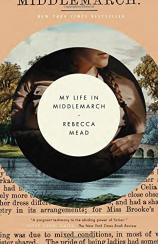My Life in Middlemarch
Review
My Life in Middlemarch
In his 2007 book, THE TOP TEN, critic J. Peder Zane collected lists of the favorite books of 125 contemporary writers. The 10th most popular choice was George Eliot’s MIDDLEMARCH, ranking only behind HAMLET in the category of British works. New Yorker writer Rebecca Mead wasn’t a contributor to Zane’s compilation, but based on her consistently engaging MY LIFE IN MIDDLEMARCH, a multifaceted tour of this magisterial work, there’s little doubt what novel would top her list.
Mead’s book is kin to recent works like William Deresiewicz’s A JANE AUSTEN EDUCATION and Laura Miller’s THE MAGICIAN’S BOOK, an appreciation of C.S. Lewis’s CHRONICLES OF NARNIA. Like a skilled chef preparing a sumptuous stew, Mead has hit upon just the right mix of ingredients --- biography, literary criticism and memoir --- to give the resulting product wide appeal. With Deresiewicz and Miller, she shares a talent for unaffected prose that’s never about displaying her erudition, while communicating an informed passion for her subject.
Early in the book, Mead makes a statement that sets the tone for all that follows: “There are books that seem to comprehend us just as much as we understand them, or even more. There are books that grow with the reader as the reader grows, like a graft to a tree.” Encountering MIDDLEMARCH for the first time as an intellectually restless 17-year-old in a nondescript coastal town in southwest England, she “couldn’t believe how relevant and urgent it felt.”
"So lucid is Mead’s narrative that no familiarity with MIDDLEMARCH is required to enjoy and appreciate this book. At the same time, readers who share her passion for the novel will take it as a spur to return to it, eager for their own rereading."
That feeling persisted through multiple rereadings, as Mead completed her education at Oxford, moved to America, landed a job as a magazine fact checker and embarked on her writing career. Along the way she had her share of relationships, culminating in a marriage that brought with it three children, followed by one born of that union. Now in her 40s, she deftly interweaves these life experiences with those of MIDDLEMARCH’s characters and the life of George Eliot herself. Perhaps the best example of her skill occurs in the chapter that focuses on Eliot’s relationship with George Henry Lewes, the man she met in 1851 and lived with, unmarried, for nearly 25 years. In that chapter, Mead, as the mother of three stepsons, like Eliot, describes with great empathy the role of a stepparent, identifying herself with Eliot’s “experience of unexpected family.”
Mead would be the first to concede she’s no Eliot scholar, and she readily acknowledges her debt to those in the field. What she brings to the story, apart from her deep engagement with the novel and its author, is the dogged persistence of the journalist (her previous book was an expose of the modern American wedding industry). Along with extensive research in American and British libraries, she visited the places where Eliot lived, journeys that enabled her to hold one of the pens Eliot used to write MIDDLEMARCH or examine a first edition of the novel inscribed in Eliot’s own hand, and that give the book an intensely personal feeling.
As for her analysis of MIDDLEMARCH itself, a novel she characterizes as “intensely moral,” but “not a moral codebook,” Mead adopts the interesting technique of structuring her own book by adopting the titles of the eight volumes of the novel (it was produced in serial form in 1871 and 1872) as her own chapter titles. In each one, she deals with different characters and themes, using them as her entry points for reflections on the work and its deep roots in Eliot’s own life, as when she teases out the affinities between George Henry Lewes and the character Will Ladislaw, or describes the real-life Rector of Oxford’s Lincoln College and his wife, who may have inspired Eliot’s portrayal of the doomed marriage of Edward Casaubon and Dorothea Brooke.
So lucid is Mead’s narrative that no familiarity with MIDDLEMARCH is required to enjoy and appreciate this book. At the same time, readers who share her passion for the novel will take it as a spur to return to it, eager for their own rereading. “A book may not tell us exactly how to live our own lives,” Mead writes, “but our own lives can teach us how to read a book.” That’s a beautiful reminder of the joy of revisiting a cherished book, not because it changes, but because we do.
“The books we love, love us back,” the great critic John Leonard once said. At least when it comes to MIDDLEMARCH, Rebecca Mead certainly would endorse that view. While we may not all be able to express our love for our favorite books with her grace, with her we can share the sentiments that inspired this lovely book.
Reviewed by Harvey Freedenberg on January 30, 2014
My Life in Middlemarch
- Publication Date: January 27, 2015
- Genres: Nonfiction
- Paperback: 320 pages
- Publisher: Broadway Books
- ISBN-10: 030798477X
- ISBN-13: 9780307984777





